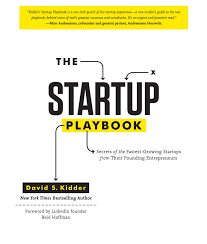White Paper: Insights from The Startup Playbook: Secrets of the Fastest-Growing Startups from Their Founding Entrepreneurs
Executive Summary
David S. Kidder's The Startup Playbook provides an in-depth exploration of the mindsets, strategies, and execution frameworks that drive successful startups. Drawing insights from over 40 influential entrepreneurs, the book serves as a blueprint for founders looking to build scalable, high-growth businesses. This white paper expands on the core lessons, providing real-world applications, industry-specific insights, actionable recommendations, and use cases for aspiring entrepreneurs.
Introduction
The startup ecosystem is inherently uncertain, yet some businesses achieve exponential growth while others struggle to survive. What differentiates these successful ventures? The Startup Playbook identifies key patterns among high-performing startups, focusing on idea validation, team dynamics, product-market fit, adaptability, and financial management.
This white paper distills these insights, connecting them to practical applications and industry-specific strategies that entrepreneurs can leverage to enhance their chances of success. Additionally, we explore how companies like Keen Computer and IAS Research can support startups in achieving their goals.
Key Insights from The Startup Playbook
1. The Idea: Foundation of Success
Clarity and Passion
Successful startups begin with a clear, compelling idea that solves a real-world problem. Passion and deep domain knowledge enable founders to articulate their vision effectively and rally stakeholders (Blank & Dorf, 2020).
Use Case: Airbnb founders Brian Chesky and Joe Gebbia faced initial skepticism but validated their idea through a small-scale test, renting out their apartment and iterating based on customer feedback.
Uniqueness and Disruption
Groundbreaking startups often challenge industry norms or introduce novel solutions. They actively seek user feedback to refine their ideas (Christensen, 1997).
Use Case: Uber disrupted traditional taxi services by leveraging mobile technology for on-demand ride-sharing, creating a scalable and efficient transportation model.
Iterative Development
Launching with a Minimum Viable Product (MVP) allows startups to test assumptions and pivot based on real user feedback (Ries, 2011).
Use Case: Dropbox initially launched with a simple demo video to gauge interest before developing the full product, ensuring product-market fit before heavy investment.
2. Building a Strong Team
Diverse Skill Sets
A well-balanced founding team possesses technical expertise, industry knowledge, and business acumen (Collins, 2001).
Use Case: Microsoft’s co-founders, Bill Gates and Paul Allen, complemented each other—Gates focused on product vision and business strategy, while Allen contributed deep technical knowledge.
Cultural Alignment
Shared values and clear communication foster collaboration and resilience (Sinek, 2009).
Use Case: Zappos implemented a cultural alignment hiring process to maintain a strong, unified team, enhancing employee retention and customer satisfaction.
Equity and Role Clarity
Early agreements on ownership, responsibilities, and decision-making processes prevent disputes and align incentives (Horowitz, 2014).
Use Case: Facebook’s early-stage conflicts over equity distribution highlight the importance of formalizing agreements early to avoid future legal and operational issues.
3. Creating a Great Product
Customer-Centric Approach
Engaging users early helps refine products based on real needs rather than assumptions (Lafley & Martin, 2013).
Use Case: Instagram pivoted from a location-based check-in app to a photo-sharing platform after observing user behavior, leading to rapid adoption.
Continuous Improvement & Simplicity
Focusing on core functionalities and iterating based on feedback leads to superior products (Maurya, 2012).
Use Case: Apple’s iPhone success is rooted in its emphasis on user experience, simplicity, and continuous innovation.
4. Adaptability: The Key to Longevity
Pivoting Strategies
Startups must remain flexible to shift strategies based on market dynamics (McGrath, 2013).
Use Case: Slack started as a gaming company before pivoting to enterprise communication after identifying a stronger market need.
Resilience Amid Uncertainty
Decision-making with incomplete information is an essential entrepreneurial skill (Tidd & Bessant, 2020).
Use Case: Tesla took strategic risks in battery technology and manufacturing, ultimately establishing itself as a leader in electric vehicles despite initial financial challenges.
5. Financial Discipline
Resource Efficiency
Startups must be capital-efficient, focusing on sustainable growth (Thiel, 2014).
Use Case: Basecamp’s founders emphasized profitability from day one, avoiding excessive venture capital dependence.
Lean Methodology
Using MVPs and iterative development reduces waste and maximizes learning (Osterwalder & Pigneur, 2010).
Use Case: Amazon initially focused on books as a niche market before expanding, allowing it to build a scalable e-commerce infrastructure.
Industry-Specific Applications
SaaS (Software as a Service)
- Focus on iterative development and user feedback.
- Use Case: Zoom’s rapid iteration and focus on usability made it a leader in video conferencing.
E-Commerce
- Prioritize customer experience and seamless logistics.
- Use Case: Shopify evolved its platform based on merchant needs, driving widespread adoption.
AI & Deep Tech
- Long R&D cycles require patient investment and strategic partnerships.
- Use Case: OpenAI’s collaboration with Microsoft enabled rapid advancements in AI applications.
References
- Blank, S., & Dorf, B. (2020). The Startup Owner's Manual. K&S Ranch.
- Christensen, C. (1997). The Innovator’s Dilemma. Harvard Business Review Press.
- Collins, J. (2001). Good to Great. HarperBusiness.
- Horowitz, B. (2014). The Hard Thing About Hard Things. HarperBusiness.
- Lafley, A. G., & Martin, R. (2013). Playing to Win: How Strategy Really Works. Harvard Business Review Press.
- Maurya, A. (2012). Running Lean. O'Reilly Media.
- McGrath, R. G. (2013). The End of Competitive Advantage. Harvard Business Review Press.
- Osterwalder, A., & Pigneur, Y. (2010). Business Model Generation. Wiley.
- Ries, E. (2011). The Lean Startup. Crown Business.
- Sinek, S. (2009). Start with Why. Portfolio.
- Thiel, P. (2014). Zero to One. Crown Business.
- Tidd, J., & Bessant, J. (2020). Innovation and Entrepreneurship. Wiley.
Conclusion
The Startup Playbook provides a comprehensive guide to building successful startups, emphasizing adaptability, customer focus, strong team dynamics, and financial prudence. By applying these principles and leveraging strategic partnerships, entrepreneurs can increase their likelihood of success in competitive markets.
Keen Computer and IAS Research stand ready to assist founders in navigating their startup journey, from product development to scaling operations. By embracing these proven strategies, startups can position themselves for sustainable growth and long-term success.



